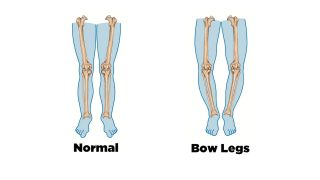Genu Varum (Bowed Legs) جينو فاروم (تقوس الساقين)

Written by Michelle Champlin BSc Pod., M.Ch.S., S.R., Ch., (UK)
Genu Varum is the medical term for outwardly bowed legs. Specifically, the lower leg appears to bow out in relation to the thigh. (This is the opposite condition to Genu Valgum – you can find out more about this here).
Genu Valgum (knock kneed); Genu Varus (bowlegged) – it’s vital to have your child’s feet and legs checked when they start school
The appearance of ‘bow legs’ is very normal in young children up until the age of about 3 years old. You may notice the child sits with the soles of the feet facing together, and that there is gap between the knee joints when the legs are out straight together on the floor, ankles together. As the child’s bones grow during the first year particularly, the knees begin to come together, the femur (thigh bone) slops down and towards the knee joint and the tibia (lower leg) straightens. As the bones ossify and harden, they become ready to bear the bodyweight as they begin to toddle and walk. Foot arches also begin to develop as the child walks more.
Bowlegs can persist for a number of reasons:
• Rickets Disease
• Malnutrition
• Infection or disease (such as Blount’s Disease)
• Physical trauma (especially to the growth plates of the femur)
• Acquired through occupations such as jockeying
• Congenital (inherited)
In most cases, there are no symptoms and the child can walk without significant problems in adulthood. However, due to the musculoskeletal malalignment of the lower leg, more stress is put through joints such as the knee. Whilst osteoarthritis is to some degree a normal ‘wear and tear’ part of aging, those with bowlegs are more prone to suffering it relatively early (age 30) and to a greater degree.
The vital message is to have all children screened for foot, ankle or leg abnormalities by the time they start primary school by a qualified Podiatrist, advises Chief Podiatrist Michelle Champlin. This allows for any issues to be identified and treated whilst bones are still growing and ossifying, avoiding more serious problems in adulthood.
If you are worried about your child (check out our blog for the top 5 signs of children’s foot problems), or to book a routine foot/leg check up, make an appointment with the children’s biomechanics specialists at Dubai Podiatry Centre. UK qualified and licensed Podiatrists, the assessments are fun and friendly and will pick up any issues requiring intervention early. Contact Dubai Podiatry Centre on +971 4 3435390 today.
بقلم ميشيل شامبلين
جينو فاروم هو المصطلح الطبي للسيقان المنحنية ظاهريًا. على وجه التحديد، يبدو أن الجزء السفلي من الساق ينحني بالنسبة للفخذ. (هذا هو الشرط المعاكس لـ جينو فاروم – يمكنك معرفة المزيد حول هذا هنا).
جينو فاروم (ضرب بالركبة) ؛ جينو فاروم (تقوس الأرجل) – من الضروري فحص قدمي طفلك وساقيه عندما يبدأ المدرسة
يعد ظهور “تقوس الساقين” أمرًا طبيعيًا جدًا عند الأطفال الصغار حتى عمر ٣ سنوات تقريبًا. قد تلاحظين أن الطفل يجلس مع توجيه باطن القدمين لبعضهما البعض، وأن هناك فجوة بين مفاصل الركبة عندما تكون الأرجل مستقيمة معًا على الأرض، والكاحلان معًا. مع نمو عظام الطفل خلال السنة الأولى بشكل خاص، تبدأ الركبتان في الالتحام، وينحدر عظم الفخذ (عظم الفخذ) إلى الأسفل نحو مفصل الركبة، ويستقيم عظم الساق (أسفل الساق). عندما تتعظم العظام وتتصلب، تصبح جاهزة لتحمل وزن الجسم عندما تبدأ في المشي والمشي. تبدأ أقواس القدم أيضًا في التطور عندما يمشي الطفل أكثر.
يمكن أن يستمر تقوس الساقين لعدة أسباب:
• مرض الكساح
• سوء التغذية
• العدوى أو المرض (مثل مرض بلونت)
• الصدمات الجسدية (خاصة في صفائح النمو في عظم الفخذ)
• يتم الحصول عليها من خلال مهن مثل المناورة
• خلقية (موروثة)
في معظم الحالات، لا توجد أعراض ويمكن للطفل المشي دون مشاكل كبيرة في مرحلة البلوغ. ومع ذلك، بسبب سوء اصطفاف العضلات والعظام في أسفل الساق، يتم وضع المزيد من الضغط على المفاصل مثل الركبة. في حين أن هشاشة العظام هي إلى حد ما جزء طبيعي من الشيخوخة، فإن الأشخاص الذين يعانون من تقوس الساقين هم أكثر عرضة للمعاناة منه في وقت مبكر نسبيًا (سن ٣٠ عامًا) وبدرجة أكبر.
وتتمثل الرسالة الحيوية في إجراء فحص لجميع الأطفال بحثًا عن تشوهات في القدم أو الكاحل أو الساق بحلول الوقت الذي يبدأون فيه المدرسة الابتدائية على يد طبيب أقدام مؤهل، كما تنصح رئيسة أطباء الأقدام ميشيل شامبلين. وهذا يسمح بتحديد أي مشكلة وعلاجها بينما لا تزال العظام في طور النمو والتعظم، مما يؤدي إلى تجنب المشكلات الأكثر خطورة في مرحلة البلوغ.
إذا كنت قلقًا بشأن طفلك (راجع مدونتنا للتعرف على أهم ٥ علامات لمشاكل قدم الأطفال)، أو لحجز فحص روتيني للقدم/الساق، حدد موعدًا مع أخصائيي الميكانيكا الحيوية للأطفال في مركز دبي لعلاج الأرجل. أطباء الأقدام المؤهلون والمرخصون في المملكة المتحدة، التقييمات ممتعة وودية وستلتقط أي مشكلات تتطلب التدخل مبكرًا. اتصل بمركز دبي للعناية بالاقدام على الرقم ٠٤٣٤٣٥٣٩٠ اليوم.

